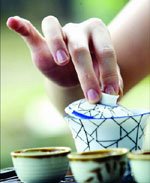Tea Trick 1
Today I'm drinking a green tea - Longjing tea. But it's not the ordinary sort. I turned it up a notch. I added a special ingredient. Can you guess what it is? No, it's not sugar. It's osmanthus flowers. They're tiny little flowers from the gui tree (Osmanthus fragrans). Osmanthus is called gui in Chinese. Osmanthus flowers are known as gui hua.
"But why?" you ask. Why would I adulterate famous tea with another ingredient? The answer is simple. I got bored, so I tried experimenting. I have added osmanathus flowers to various oolong teas before, but didn't get any spectacular result. But this time, was different. Wow, what a difference those flowers made to the tea. Normally, longjing has a bit of a bitter aftertaste. But when I mixed osmanthus flowers in, it didn't have any bitter aftertaste at all. The tea infusion was quite sweet, and very fragrant, with that characteristic osmanthus fragrance.
I used one of those porcelain teapots specially made for flower teas. Longjing tea is quite interesting. Though it's a green tea, it can stand up to hotter water temperatures very well. I used near boiling water and steeped for 2 minutes, then decanted into a chahai. I'm not sure about the exact amount of tea or flower I used. I don't use a gram scale. But I used a smaller quantity of flower than the longjng tea.
Actually, this longjing tea was not fresh. It was sitting in my cupboard in a tea tin for maybe a few years. Only now am I getting to drink it. If you have some old tea sitting in your back cupboard, try something new with it if you find the tea has lost its flavor. Adding osmanthus flowers is a good trick to bring an old tea back to life.
So there you have it, tea trick number 1.
If you have a chance, certainly buy some osmanthus flowers. They're worth it.
Immortal's Palm Tea
-
by STEVEN D. OWYOUNG
AUTHOR'S NOTE: *This essay is dedicated to Frank Hadley Murphy, author of
The Spirit of Tea, for his kind introduction to the poet Li B...
14 years ago


No comments:
Post a Comment